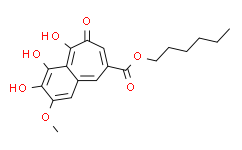Title:Discovery of Small-Molecule Inhibitors of the TLR1/TLR2 Complex
标题:发现TLR1/TLR2复合物的小分子抑制剂
Authors:Cheng K. et al
Journal:Angewandte Chemie International Edition
Publication Date:2012
Key Findings:
1. Identification of Inhibitors: The study discovered and synthesized several small molecules, among which CU-CPT22 was found to be the most effective inhibitor of the TLR1/TLR2 complex.
2. Mechanism of Action: These inhibitors work by blocking the interaction between TLR1 and TLR2, thereby preventing the downstream signaling that leads to inflammatory responses.
3. Experimental Validation: The efficacy of CU-CPT22 was validated through various biochemical and cell-based assays, demonstrating its potential as a therapeutic agent for diseases involving excessive TLR1/TLR2 activation.
Significance:
- This research opens new avenues for the development of anti-inflammatory drugs targeting the TLR1/TLR2 complex.
- It provides a deeper understanding of the molecular mechanisms underlying TLR-mediated immune responses.
主要发现:
1. 抑制剂的识别:研究发现并合成了几种小分子,其中CU-CPT22被发现是TLR1/TLR2复合物的最有效抑制剂。
2. 作用机制:这些抑制剂通过阻断TLR1和TLR2之间的相互作用,从而阻止导致炎症反应的下游信号传导。
3. 实验验证:通过各种生化和细胞实验验证了CU-CPT22的有效性,显示出其作为治疗过度TLR1/TLR2激活相关疾病的潜力。
意义:
- 这项研究为开发靶向TLR1/TLR2复合物的抗炎药物开辟了新途径。
- 它加深了对TLR介导的免疫反应分子机制的理解。





 沪公网安备31011402010657号
沪公网安备31011402010657号